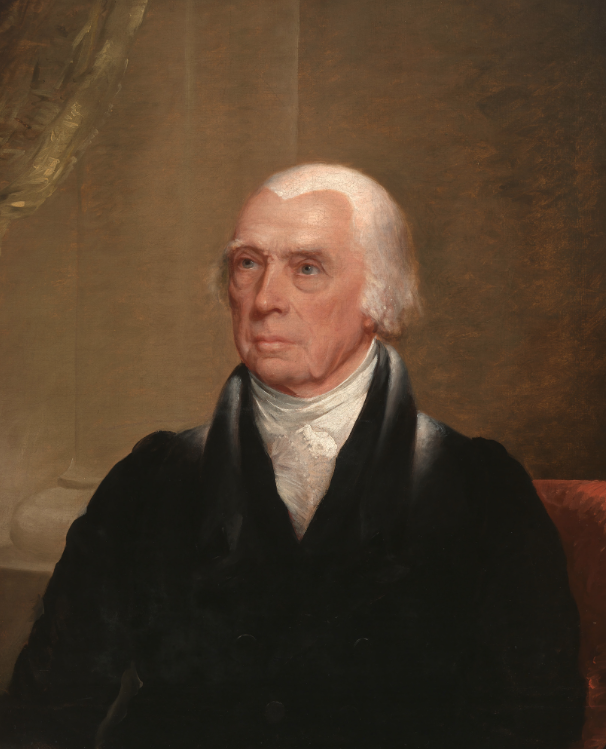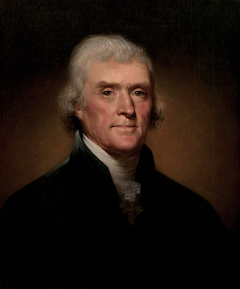Jeffersonian Project: James Madison
Daniel Goodman
M/J United States History
Ms. Kooiker
6/13/23
Jeffersonian
Project: James Madison
James Madison is one of the three Jeffersonian presidents
and is additionally the second of them to be elected (“James Madison | The
White House”). He was born in Port Conway, Virginia, on the day of March 16th,
1751 (“James Madison Biography”). Madison had a rather calm childhood; he was taught
by Donald Robertson from when he was eleven to sixteen, and then studied at the
College of New Jersey after some further learning (“James Madison Biography”;
“The Life of James Madison”). He graduated in 1771 and would go on to study
political philosophy and the language of Hebrew (“The Life of James Madison”).
Madison’s role in politics would begin when he was made a
member of the Orange County Committee of Safety in 1774 (“The Life of James
Madison”). Afterwards, he and Thomas Jefferson would meet and become good
friends, and Madison would rise the ranks until he served in Virginia’s state
legislature in 1783 (“James Madison Biography”). Then, in 1787, he attended the
Constitution Convention and was the representative for Virginia (“James Madison
Biography”; “The Life of James Madison”). Madison would go on to help write
papers that persuaded the ratification of the Constitution and would then climb
the ranks further until he attained presidency in 1808 (“James Madison
Biography”). He would go on to serve two terms as president and died on June 28th,
1836 (“James Madison Biography”; “James Madison | The White House”).
In terms of accomplishments, though, Madison has
accomplished an array of astounding feats. Most notably, Madison was a major
contributor to the Constitution, and due to this, he has since earned the title
of being the father of the Constitution (Reynolds). Not only did Madison help
heavily persuade the ratification of the Constitution, but he gave input more
than two hundred times during the convention, which was the most of anyone
there (“James Madison Biography”; Reynolds). Additionally, Madison was also a
key determiner of the ideas featured within the Constitution (Reynolds).
Further, Madison also was a leading factor in determining
the limits and purpose of the Constitution, which cements Madison’s title as
being the father of the Constitution (Reynolds; “The Life of James Madison”). Madison’s
overall contribution to the Constitution is one of his biggest accomplishments,
but as aforementioned, he has also done a few other pivotal things. For
example, as well as being known as the father of the Constitution, Madison is
also considered to be the father of the Bill of Rights (Reynolds). In fact,
Madison was the one who proposed the Bill of Rights to the house of
representatives in the first place (Reynolds; “The Life of James Madison”).
Some of the things that Madison tried to argue for
include freedom of religion and speech, in which both would find their way into
the Bill of Rights (Reynolds). Overall, Madison made a list of nineteen
proposals, however, only ten would be ratified by the states (“The Life of
James Madison”). To top these two accomplishments off, however, Madison also
had a role in helping form the structure of American government itself (Reynolds).
He did this by making the Virginia Plan, which ultimately caused the three
branches of government to be created (Reynolds; “The Life of James Madison”).
At a first glance, Madison has had a monumental impact on
American democracy. In a sense, he had a leading role in developing and shaping
the government that is seen in modern times. Not only was he responsible for
balancing out the power between the legislative branches, but he was
practically responsible for their creation as well (Reynolds). Additionally,
Madison also was key in the making of the Constitution, which basically set up
American democracy itself (Reynolds; “The Life of James Madison”).
More specifically, the ideas stated in the Constitution culminate
in a way that forms a federal democratic republic (“Our American Government”).
As aforementioned, Madison was prominent in the Constitution’s creation,
meaning that he is responsible for some of the impact it caused (Reynolds; “The
Life of Madison”). Madison also had a major role in the creation of the Bill of
Rights, which also affected democracy greatly (Reynolds). The Bill of Rights changed
democracy in the sense that the government would not have as much control over
certain rights (“The Bill of Rights”).
In conclusion, Madison has had a great impact on America
democracy through a multitude of ways. For instance, he structured parts of the
government, limited the powers of the government, and ultimately made the three
legislative branches (Reynolds; “The Life of Madison”). The change that Madison
brought about to America is still very prevalent to this day, and he is partially
the reason why the government is running the way it is today. Without him,
America would be a lot messier to live in, and American democracy may be
hectic.
Harding, Chester. “James Madison.” National Portrait Gallery, 1830, npg.si.edu/object/npg_NPG.68.50. Accessed 13 June 2023.
“James Madison Biography.” Biography.com,
10 May 2021, www.biography.com/political-figures/james-madison. Accessed 13
June 2023.
“James Madison | The White House.” The
White House, 2023, www.whitehouse.gov/about-the-white-house/presidents/james-madison.
Accessed 13 June 2023.
“Our American Government.” Congressman
James E. Clyburn, 2023, clyburn.house.gov/fun-youth/us-government. Accessed
13 June 2023.
Reynolds, Alicia. “What Were James
Madison’s Accomplishments?” Constitution of the United States, 11 Feb.
2023, constitutionus.com/presidents/what-were-james-madisons-accomplishments.
Accessed 13 June 2023.
“The Bill of Rights.” American Government
Online Textbook, 2023, www.ushistory.org/gov/2d.asp. Accessed 13 June 2023.
“The Life of James Madison.” Montpelier,
www.montpelier.org/learn/the-life-of-james-madison. Accessed 13 June 2023.



Comments
Post a Comment